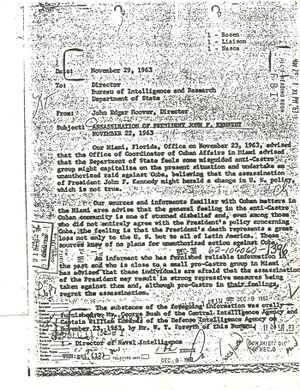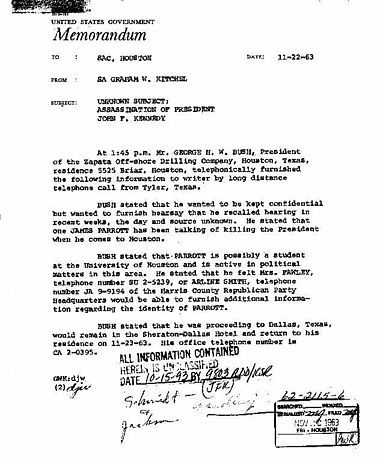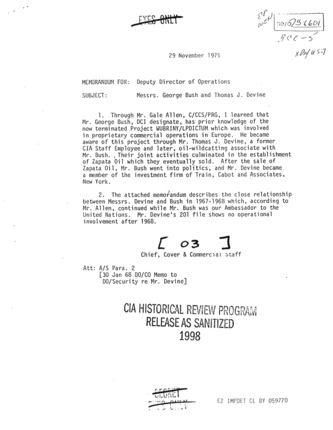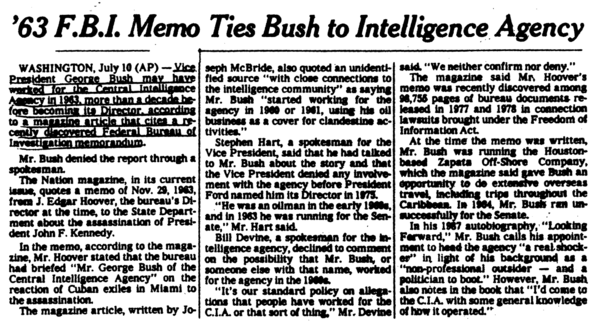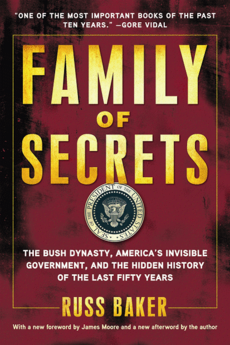George H. W. Bush/Exposure
(exposure) | |
|---|---|
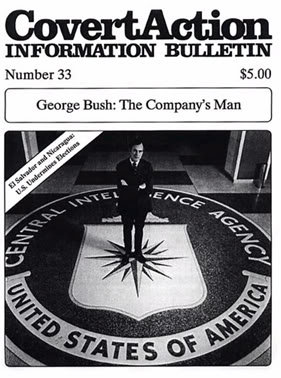 CovertAction Quarterly, founded by CIA whistleblower Phil Agee, ran an expose of George H. W. Bush in 1992. | |
| George H. W. Bush was a spook his entire adult life. He attempted to erase all documentary evidence of this, but a few documents escaped, and he was tripped up by steps he took to try to obscure his connection to the JFK assassination. Corporate media showed minimal interest in the story, but independent media have built a well document and coherent picture of Bush's secret life as head of the US deep state. |
George H. W. Bush's had a secret life in the CIA (and US Deep state))[1]. Although hidden from the US public for over half a century, his secret life was well exposed by Family of Secrets, Russ Baker's 2005 expose of the Bush Family.[2]. As CIA Director, US Vice president and then US President he apparently attempted to destroy all documentary evidence of his secret past,[3] but was ultimately unsuccessful.
Surviving documents
When Gerald Ford broke with tradition to appoint Bush to head the CIA, some members of the House and Senate intelligence committees and their staffs were suspicious,[4] but no documents suggesting that Bush was a CIA insider would by published until 1988.
1963 FBI Memo (discovered 1985, exposed 1988)
In 1985, author Joseph McBride was in the library of California State University San Bernadino, researching Frank Kapra. Looking through micofilmed memos, he chanced upon one under the subject heading of "Assassination of President John F. Kennedy", from J. Edgar Hoover, dated 29 November 1963, concerning a report that mentioned a "Mr. George Bush of the Central Intelligence Agency". At the time, McBride was busy with other things and so didn't follow up until his 1988 article in The Nation, The Man Who Wasn't There, 'George Bush,' C.I.A. Operative.
Parrott Phonecall (exposed 1988)
On 25 August 1988, the San Francisco Examiner published an article by Miguel Acoca with the headline Documents: Bush Blew Whistle on Rival in JKF Slaying, citing an FBI document[Which?][citation needed] that recorded that a man who identified himself as George H. W. Bush had phoned the FBI in Houston to report that James Parrott had "been talking of killing the president". When Acoca called the US Vice President's office, and asked about this, a spokesman reported that Bush "does not recall" making the phonecall. Although it was only a week since George H. W. Bush had accepted the Republican presidential nomination, US corporate media showed almost no interest in the story.
November 1963 Parrott Memo (exposed 1993)
- Full article: Parrott Memo
- Full article: Parrott Memo
In 1993, under Bill Clinton's presidency, the complete FBI memo about the Parrott Phonecall was declassified, dated 22 November 1963. This too went apparently unnoticed by corporate media. It may however have prompted the inclusion in Barbara Bush's 1994 memoir of fragments of a letter that she claims she wrote while the JFK was happening, in which she mentions that her husband was in Tyler, Texas at the time of the assassination.
1975 WUBRINY Memo (exposed 2006)
- Full article: Document:1975 WUBRINY Memo
- Full article: Document:1975 WUBRINY Memo
In 2006, Jerry Shinley was researching the JFK Assassination, reviewing the digitized documents on the website of the Mary Ferrell foundation. He found a letter from 29 Novermber 1975, declassified in 1996, that stated that "Through Mr. Gale Allen... I learned that Mr. George Bush, DCI designate, has prior knowledge of the now terminated project WUBRINY/LPDICTUM which was involved in proprietary commercial operations in Europe. He became aware of this project through Mr. Thomas J. Devine, a former CIA staff employee and later, oil-wildcatting associate with Mr. Bush. Their joint activities culminated in the establishment of Zapata Oil [sic]..." This established that Bush was working for the CIA by 1953, when Zapata Petroleum was established.[5] This prompted Russ Baker to interview Thomas Devine in Winter 2007.[6]
Reporting
After the first expose, Joseph McBride's 1988 The Man Who Wasn't There, 'George Bush,' C.I.A. Operative in The Nation, various authors have assembed the research of earlier authors and continued to draw an ever larger and more focussed picture of the covert activities and relationships of George H. W. Bush.
1988 - The Man Who Wasn't There, 'George Bush,' C.I.A. Operative
In July 1988, McBride published an article in The Nation, entitled The Man Who Wasn't There, 'George Bush,' C.I.A. Operative[7] This report was picked up the 11 July 1988 issue of the New York Times, which headlined their story "'63 F.B.I. Memo Ties Bush to Intelligence Agency".[8]
1992 - Anthony Kimery in Covert Action Quarterly
In 1992, investigative journalist Anthony Kimery published an article in Covert Action Quarterly what he described as an "in-depth exposé of Bush’s covert-related activities" that examines the "growing body of evidence that for almost half a century, Bush has been a Company man." It was republished online in 2018 as Document:George Bush and the CIA In the Company of Friends.
2008 - Russ Baker's Family Of Secrets
- Full article: Family Of Secrets
- Full article: Family Of Secrets
Russ Baker surmises that "Bush's own role within intelligence appears to date back as early as the Second World War, when he joined the Navy at age eighteen".[5] Evidence cited includes Prescott Bush's connections, the fact that Bush was tasked with sensitive photograph missions during WW2 and the speed with which he was given major CIA responsibility.
2013 - Mark Gorton's Fifty Years of the Deep State
- Full article:
 Document:Fifty Years of the Deep State
Document:Fifty Years of the Deep State
- Full article:
On the 50th anniversary of the JFK Assassination, Mark Gorton distributed an unfinished essay he entitled Fifty Years of the Deep State to his employees. This reached a wider audience when it was published on the internet at Gawker, and made into an audiobook[9] and broadcast on the Unwelcome Guests' radio show.[10][11]
Response
The US Deep state have ultimately failed to prevent the exposure of George H. W. Bush on the internet. By the time of his death, the story of his secret life was well documented on countless websites and in numerous published books.
George William Bush
In 1988, when Bush was US Vice President, McBride asked about this memo and Stephen Hart, Bush's spokesman, reported that Bush stated it must have been a different George Bush, something the CIA refused to confirm or deny. After McBride published his discovery in the 16 July 1988 edition of The Nation magazine, under the title The Man Who Wasn't There, 'George Bush', C.I.A. Operative, a CIA spokeswoman Sharron Basso told the Associated Press that "the record should be clarified", and that the FBI memo "apparently" refered to a George William Bush, who worked the night shift from September 1963 to February 1964.
The CIA then claimed that they were unable to locate their former employee George William Bush, but Joseph McBride quickly located him, still on the US government payroll, working as a claims representative for the Social Security Administration. He denied that he was the George Bush mentioned in the memo, and stated that he had never been to interagency briefings. George William Bush stated under oath that he was not the man referred to by the memo. His testimony was confirmed in 1991 by the other man, William Edwards who was mentioned in the memo.[5]
"Fake news"
The exposure of George H. W. Bush is one of many such internet based exposures of the deep state which are suspected to have lead to the aborted "fake news website" campaign of late 2016.
Examples
| Page name | Description |
|---|---|
| Document:1963 FBI Memo mentioning Mr. George Bush of the Central Intelligence Agency | A 1963 FBI Memo which reveals that a Mr. George Bush of the Central Intelligence Agency phoned in about the JFK assassination |
| Document:1975 WUBRINY Memo | A 1975 memo from before George H. W. Bush was made DCI that reveals years of involvement in CIA operations. |
| Document:Fifty Years of the Deep State | A detailed overview of the modern US deep state which names names, the most prominent of which, George H. W. Bush, is exposed as the kingpin of the US Deep state and probable a key mover behind the 9/11 plot. |
| Document:George Bush and the CIA In the Company of Friends | An overview of Bush's CIA work and related business activity. |
| Family Of Secrets | A highly creditable expose of the US Deep State in general and the Bush family in particular. |
| The Mafia CIA and George Bush | An early expose (1992) of George H. W. Bush |
| The Parrott Memo | An FBI memo deserving of further scrutiny |
Rating
In spite of his best efforts to cover up his spooky past, GHWB's life long career as a spook is now confirmed by multiple documents. This article lays them out.
References
- ↑ [[]]
- ↑ Highly recommended to anyone seeking an overview of the development of the US deep state
- ↑ Direct evidence of this is lacking, but the disappearance of the Zapata Petroleum filings of 1960-1966 (and its timing) would indicate this.
- ↑ Document:George Bush and the CIA In the Company of Friends
- ↑ a b c Cite error: Invalid
<ref>tag; no text was provided for refs namedghwbjfkhit - ↑ Family Of Secrets, p.14
- ↑ https://web.archive.org/web/20120326133224/http://inquirer.gn.apc.org/bush_story.html
- ↑ https://www.nytimes.com/1988/07/11/us/63-fbi-memo-ties-bush-to-intelligence-agency.html
- ↑ http://radio4all.net/index.php/program/75651
- ↑ http://www.unwelcomeguests.net/686
- ↑ http://www.unwelcomeguests.net/687
